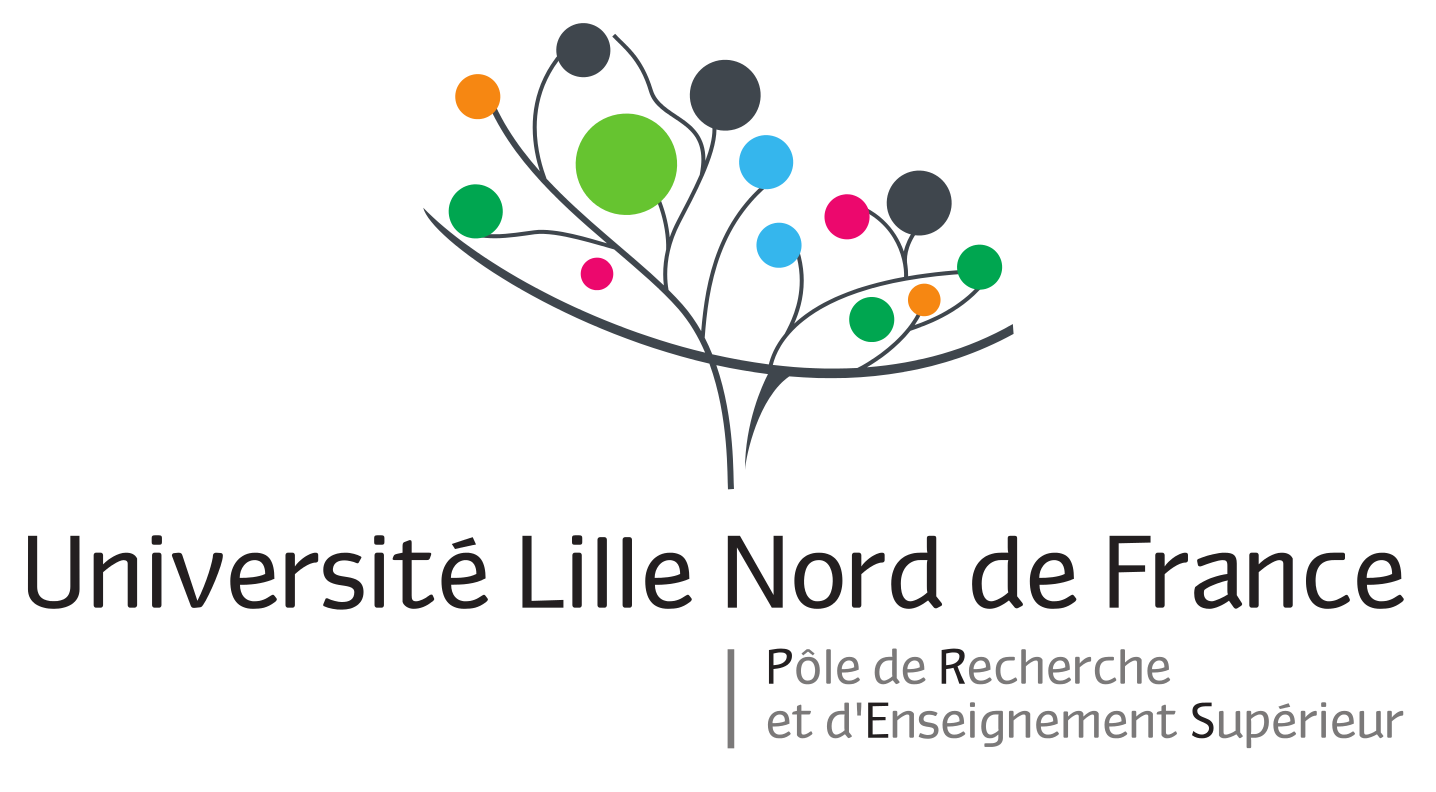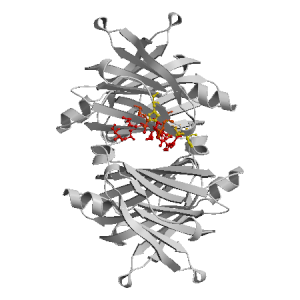 |
LigASite database of binding sites |
|
PDB ID and HEADER, TITLE and
COMPND records of the PDB file. | | (click anywhere in this window to remove it) |
|
| 2qgb |
| HORMONE/GROWTH FACTOR |
HEADER |
|
|
| HUMAN TRANSTHYRETIN (TTR) IN APO-FORM |
TITLE |
|
|
|
|
|
|
Figure highlighting the binding site residues. Figures were drawn with
Molscript (7) and rendered with
Raster3D (8). PISA coordinates
(3) are used when available
(all entries except NMR). | | (click anywhere in this window to remove it) |
|
 |
|
List of binding site residues detected in this protein. Column 1 gives the position, coloured on a yellow-to-red scale depending on the fraction of corresponding holo-structures where the residue is in contact with a ligand.
Column 2 gives the 3-letter amino acid code, coloured according to physico-chemical type. Chain ID's of residues are not mentioned in this page because all chains in the apo-structure refer to the same protein. | | (click anywhere in this window to remove it) |
|
| 13 | |
MET |
| 15 | |
LYS |
| 17 | |
LEU |
| 24 | |
PRO |
| 52 | |
SER |
| 54 | |
GLU |
| 56 | |
HIS |
| 106 | |
THR |
| 108 | |
ALA |
| 109 | |
ALA |
| 110 | |
LEU |
| 115 | |
SER |
| 116 | |
TYR |
| 117 | |
SER |
| 118 | |
THR |
| | 119 | |
THR |
| 121 | |
VAL |
| 127 | |
GLU |
| 215 | |
LYS |
| 217 | |
LEU |
| 306 | |
THR |
| 308 | |
ALA |
| 309 | |
ALA |
| 310 | |
LEU |
| 317 | |
SER |
| 318 | |
THR |
| 319 | |
THR |
| 321 | |
VAL |
| 1013 | |
MET |
| 1015 | |
LYS |
| | 1017 | |
LEU |
| 1106 | |
THR |
| 1108 | |
ALA |
| 1109 | |
ALA |
| 1110 | |
LEU |
| 1117 | |
SER |
| 1118 | |
THR |
| 1119 | |
THR |
| 1121 | |
VAL |
|
|
|
| PDB |
The Protein Data Bank |
| CSA |
Catalytic Site Atlas |
| PDBSum |
Overview of the macromolecular structure |
| CATH |
Protein Structure Classification |
| Scop |
Structural Classification of Proteins |
| Pfam |
Protein Families and Domains |
| UniProt |
Universal Protein Resource |
LIGPLOT (only on holo-pages) is hosted at the EBI. The LigPlot Jmol links point directly to the Jmol visualisation interface provided on the PDBSum page. Note that due to different software used, the atomic contacts of LigPlot and LigASite do not necessarily correspond. | | (click anywhere in this window to remove it) |
|
Links to external databases: |
|
Several files are provided for download: | • The XML file defining the residue-ligand contacts; this file contains data on the apo and all holo-structures. |
| • The XML Schema file defining the semantics of the XML file |
| • 3D coordinates of the structure used in constructing LigASite (PISA structure file whenever available, PDB file otherwise. |
| • 3D coordinates of the combined binding residues in the apo structure |
| • 3D coordinates of the binding residues of the holo structure (only on the holo page) |
Coordinate files are in PDB format. | | (click anywhere in this window to remove it) |
|
|
|
|
|
Table describing the holo-structures and ligands used to define
the binding sites.
Column 1 gives the PDB ID of the holo-structure.
Column 2 gives the unique ID of the ligand;
a space-separated list of HET-groups that constitute
the ligand (see Methods).
Each HET-group in the ligand is uniquely identified by
a string in which the first four characters are the three-letter
HET ID from the PDB file followed by the chain ID from
the PISA file, and the last four characters are the residue sequence
number from the PDB file.
Column 3 gives the number of atoms in each ligand.
Column 4 gives the number of protein-ligand inter-atomic
contacts. | | (click anywhere in this window to remove it) |
|
| pdb ID |
Ligand Unique ID |
#atoms |
#contacts |
| 2rox |
T44A_128 T44C_128 |
46 |
138 |
Details |
|
T44B_128 T44D_128 |
46 |
145 |
| 1ict |
T44A_128 T44C_128 |
24 |
113 |
Details |
|
T44B_129 T44D_129 |
24 |
116 |
| 1eta |
T44C_128 T44D_128 |
47 |
311 |
Details |
| 2flm |
6CAE_201 6CAF_201 |
64 |
261 |
Details |
| 1bm7 |
FLFE_501 FLFF_501 |
36 |
111 |
Details |
|
FLFE_502 FLFF_502 |
34 |
118 |
| 2roy |
P28A_128 P28C_128 |
54 |
171 |
Details |
|
P28B_128 P28D_128 |
54 |
164 |
| 2qgd |
MR5A_200 MR5C_200 |
28 |
117 |
Details |
|
MR5B_201 MR5D_201 |
28 |
119 |
| 2fbr |
44CE_173 44CF_173 |
57 |
218 |
Details |
| 2b77 |
3CAE_240 3CAF_240 |
30 |
105 |
Details |
|
3CAE_239 3CAF_239 |
30 |
116 |
| 2gab |
NE2E_502 NE2F_502 |
28 |
106 |
Details |
|
NE2E_501 NE2F_501 |
28 |
115 |
| 3b56 |
DIUA2000 DIUC2000 |
20 |
88 |
Details |
|
DIUB3000 DIUD3000 |
21 |
96 |
| 2g5u |
NEWE_239 NEWF_239 |
30 |
106 |
Details |
|
NEWE_240 NEWF_240 |
30 |
107 |
| 2qgc |
MR4B_128 MR4D_128 |
28 |
117 |
Details |
|
MR4A_128 MR4C_128 |
29 |
115 |
| 2b9a |
FBCE_302 FBCF_302 |
29 |
128 |
Details |
|
FBCE_301 FBCF_301 |
29 |
121 |
| 2qge |
MR6B_200 MR6D_200 |
31 |
114 |
Details |
|
MR6A_201 MR6C_201 |
33 |
117 |
| 2b15 |
DNFE___1 DNFF___1 |
21 |
80 |
Details |
|
DNFE___2 DNFF___2 |
21 |
81 |
| 1y1d |
FHIE3000 FHIF3000 |
33 |
132 |
Details |
|
FHIE2000 FHIF2000 |
33 |
126 |
| 2f7i |
26CE_326 26CF_326 |
29 |
105 |
Details |
|
26CE_325 26CF_325 |
29 |
109 |
| 2g9k |
NE1E_501 NE1F_501 |
30 |
102 |
Details |
|
NE1E_500 NE1F_500 |
30 |
98 |
| 1z7j |
T4AE_129 T4AF_129 |
41 |
132 |
Details |
|
T4AE_128 T4AF_128 |
41 |
130 |
| 1tz8 |
DESC___1 DESD___1 |
20 |
99 |
Details |
|
DESA___1 DESB___1 |
20 |
103 |
| 2f8i |
205E1002 205F1002 |
35 |
130 |
Details |
|
205E1001 205F1001 |
35 |
124 |
| 1tt6 |
DESE___1 DESF___1 |
35 |
122 |
Details |
|
DESE___2 DESF___2 |
33 |
119 |
| 1u21 |
P2CE_221 P2CF_221 |
38 |
128 |
Details |
|
P2CE_211 P2CF_211 |
36 |
136 |
|
|
|
|
v4.0
May 2008 |
Interdisciplinary Research Institute, Computational Biology, Villeneuve d'Ascq, France
University College London, Biomolecular Structure and Modelling Unit, London, UK
Hospital for Sick Children and University of Toronto, Structural Biology and Biochemistry Program, Toronto, Canada |
| Script execution time: 0.184 seconds |

